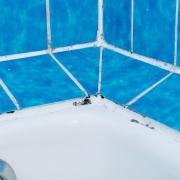Identifying Bathroom Water Damage
Bathroom water damage can significantly reduce the value of a home by reducing aesthetics and creating the possibility of expensive structural repairs. Water damage can start in a bathroom, but break through the floor to the downstairs room, wreaking havoc on the interior woodworking of the house. In addition to the nasty appearance of water damage, excess moisture often leads to high levels of mold growth inside a home.
Causes
There are several causes of water damage in bathrooms. Leaks are the leading cause of water damage, and even small leaks, such as a toilet base or water faucet, can cause serious damage if left untreated. Other sources of damages include flooding, leaking window damage, plumbing leaks or improper caulking of a bath tub.
ID
Water damage is identifiable by water stains on floors, tiles or behind furniture. These can be a variety of shapes or sizes and generally consist of a dark outer edge with a lighter interior spot. Mold is also a primary indicator of water damage. The New York State Department of Health notes that “a mold problem can usually be seen or smelled. Mold growth can often appear as slightly hairy, discolored or slug patches that increase in size as they grow.” If you suspect that you may have bathroom water damage, make a thorough inspection of your walls and floors and examine the interior of the cabinets to check for water stains.
Problems
Permanent coloring of floors, walls and tiles is very unsightly, but excess water can also cause structural damage, especially in floors. Molded mushrooms thrive in moist areas, especially in bathrooms and even in small amounts is considered a health problem caused by high levels of moisture. Mold is especially dangerous for people with allergies and often causes sneezing, coughing and congestion.
Repair
Light water coloring on tiles or walls should be removed as soon as possible with bath cleaner and a brush. Dry the area thoroughly after cleaning to avoid further damage. If decomposition of water has spread inside walls or with bathroom tiles, consult a professional plumber for evaluation, as structural repairs may be required.
Prevention
Water damage is more dangerous when undetected and allowed to diffuse and bloom. The Rocky Mountain Association of Safe Information states that “fading or soft areas around floors and walls near showers or bathtubs may be your first indication there is a leak.” Regularly examine the tile and grout to ensure there are no missing areas for caulking. Water damage is also quite common under the sink, so remove everything from the cabinets and examine the area. If your bathroom floods, quickly remove the water and dry the area carefully to avoid causing further damage. If your bathroom does not have a window, run a dehumidifier to remove excess moisture from the air.






